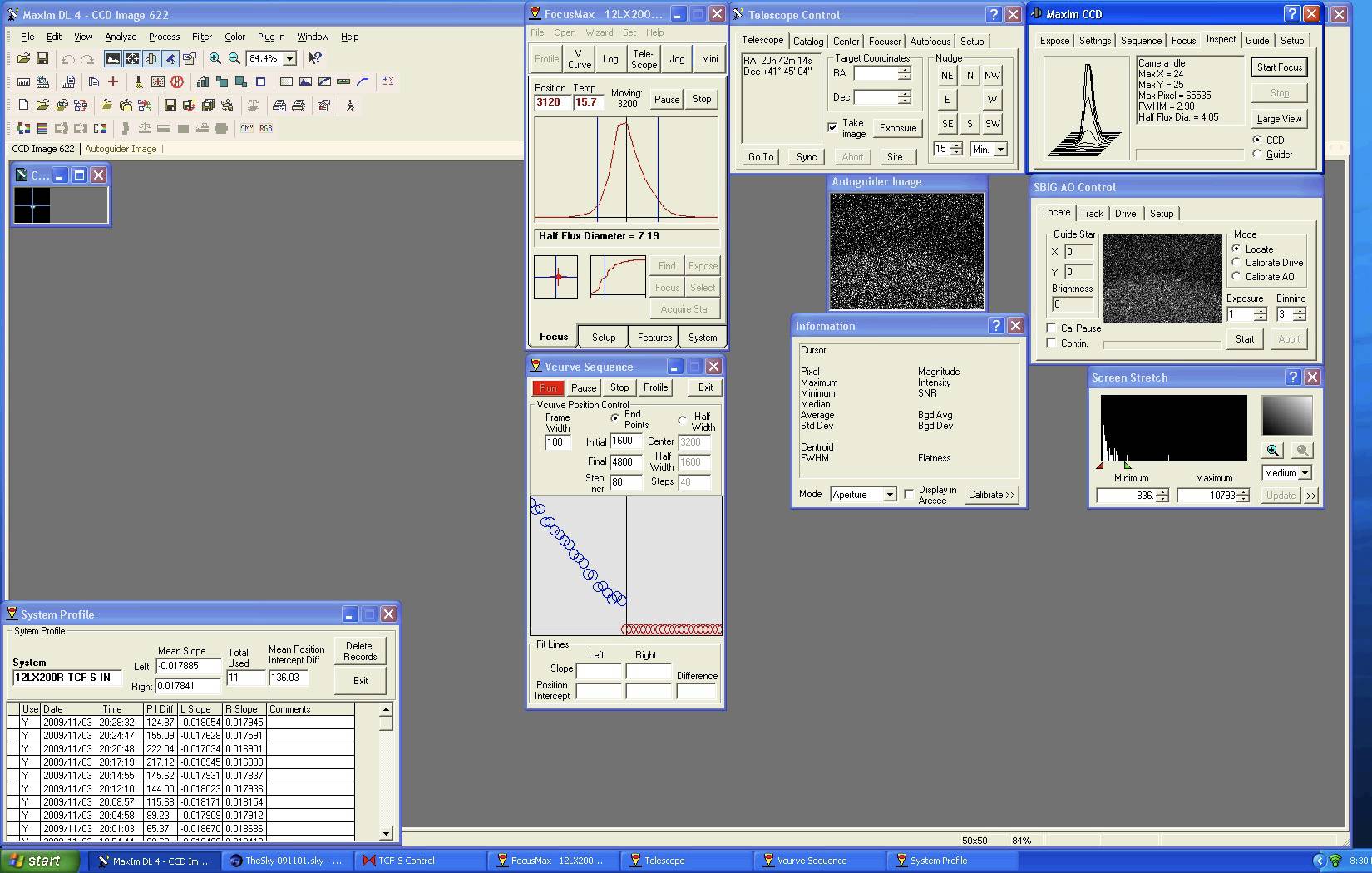FocusMax used to be an incredible free program, written by Larry Weber and Steve Brady, that works with various focusers to automate and optimize the focusing process. It is now available from CCDWare. It works by first creating a library of "V-Curves" for each optical system (telescope - reducer - camera combination). These V-curves plot the stellar diameter (i.e., out of focus blur circle) against the focuser position (i.e., adjusting focal length of the scope), and allow an estimation of the precise focal point (range). Once the V-curve library has been built, the program runs automatically, sampling the stellar size and eventually driving the focuser to the precise optimum focus position. At least in theory ... the program is quite complex with many parameters to adjust; it is not clear that I have optimum settings, although most focus runs result in incredibly good focus - much better than I have ever been able to accomplish by hand. The image below shows a typical V-curve. |
 |
The following image shows FocusMax in operation, in the process of moving the focuser and creating a V-curve. |
 |
I used FocusMax originally with a RoboFocus system on the LX200 primary mirror. It worked, but not very reliably - as there was a tremendous amount of backlash (while the focal range was about 30 steps, the backlash was about 600 steps!). Now, I am using FocusMax with the Optec TCF-S focuser, and it works very reliably, achieving incredible focus most of the time, when controlled by CCD AutoPilot, or run manually. |
Most recently, I have used FocusMax again with RoboFocus, but this time connected to the main focus shaft of the FSQ-106EDX scope. It works great, and I typically get FWHMs of stars much narrower than I could achieve by hand-focusing the scope. |
The actual process of focusing starts with FocusMax finding a suitable guidestar in the image field. It takes an image, finds a guidestar (hopefully not saturated, as you want to be in the linear range of the camera - i.e., 5,000-50,000 ADU), and then measures the FWHM of a focus image (with the star centered in a small focus box, so the camera download time is minimal). FocusMax then moves the focuser and takes another image to determine which side of focus the scope is on. You can select focusing "in" or "out", depending on what minimizes the backlash; next, FocusMax moves the focuser so that it is on the correct side of focus for further movements to go in or out, as selected. FocusMax then moves the focuser to the estimated "Near Focus" position, and begins a series of exposures and star size measurements. FocusMax uses "HFD", or half-flux density, rather than FWHM for star diameters; these seem to be about double the FWHM or half flux diameter reported by MaximDL. Finally, (if focus convergence is turned on), FocusMax takes exposures until it meets the criteria selected by the user (so many samples within so many focuser steps). Finally, having computed where the focuser is on the V-curve slope, FocusMax moves the focuser to the final position. It is almost always optimum, although sometimes, it can turn out badly - with another focus run needed. |
Focusing with FocusMax under control of CCDAutoPilot typically takes about 3 minutes, which includes slewing to the focus star, doing the focusing routine, and slewing back to the target. The time depends on the FocusMax settings, which I am still playing with - and which seem to have different optimum settings, depending on whether I'm using the TCF-S with the LX200, or the RoboFocus with the FSQ. |
Overall, FocusMax is an incredible program - using a novel concept to achieve fine focus position, having incredible flexibility of working with various scopes and optical systems, and being free! Larry Weber and Steve Brady must be congratulated for this fine software! While there are many other automatic focusing programs, I believe FocusMax is used by the majority of serious remote imagers, regardless of which focuser they are using.
|